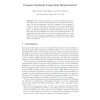Free Online Productivity Tools
i2Speak
i2Symbol
i2OCR
iTex2Img
iWeb2Print
iWeb2Shot
i2Type
iPdf2Split
iPdf2Merge
i2Bopomofo
i2Arabic
i2Style
i2Image
i2PDF
iLatex2Rtf
Sci2ools
CADE
2015
Springer
2015
Springer
Program Synthesis Using Dual Interpretation
Abstract. We present an approach to component-based program synthesis that uses two distinct interpretations for the symbols in the program. The first interpretation defines the semantics of the program. It is used to specify functional requirements. The second interpretation is used to capture nonfunctional requirements that may vary by application. We present a language for program synthesis from components that uses dual interpretation. We reduce the synthesis problem to an exists-forall problem, which is solved using the exists-forall solver of the SMT-solver Yices. We use our approach to synthesize bitvector manipulation programs, padding-based encryption schemes, and block cipher modes of operations.
| Added | 17 Apr 2016 |
| Updated | 17 Apr 2016 |
| Type | Journal |
| Year | 2015 |
| Where | CADE |
| Authors | Ashish Tiwari, Adria Gascón, Bruno Dutertre |
Comments (0)

